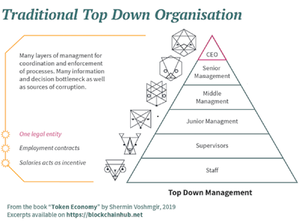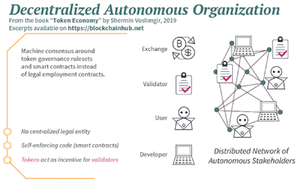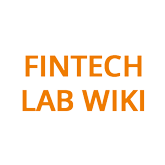Difference between revisions of "Digital Infrastructures for Decentralized Organizations"
| Line 121: | Line 121: | ||
== Useful information on DAOs available on the Internet == | == Useful information on DAOs available on the Internet == | ||
| − | |||
The following links provide a vast amount of information about the existing DAOs: | The following links provide a vast amount of information about the existing DAOs: | ||
Revision as of 19:31, 21 August 2023
In this section we review the information on digital infrastructures that are relevant to understand how technology may improv efficiency of decentralized organizations. In particular, we introduce the basic information that is relevant to become familiar with the, nowadays widespread notion of Decentralized Autonomous Organization (DAO) as commonly perceived in the crypto-space. This specific analysis will be focused on the digital infrastructure characteristics and, given the large amount of available material, will only review those sources that are relevant to the MUSA research project at hand.
Introduction
A DAO is a computer program that runs on a distributed peer-to-peer network. They are controlled by communities of online agents that collaborate and operate without the need for a central governing body. DAOs are created to operate without human involvement. This is done by transcribing organizational processes and governance protocols into algorithms. The code runs on a digital distributed ledger known as blockchain.
In centralized organizations, the power and authority to make decisions is held by executive members or top-level management. This creates a hierarchy decision-making structure where the top-level employees control and direct the organization. On the opposite end of the spectrum are decentralized organizations where decision-making is delegated and is flexible. This means that executives assign part of their responsibilities to management and communicate often to oversee processes.
A DAO is a type of decentralized organization; however, the key innovation is that DAOs are autonomous and can exist only relying on a digital infrastructure. DAOs rely on distributed ledger technology to record and enforce decisions and organizational processes. This could include aspects like issuing shares, appointing a CEO, voting on proposals, and paying salaries.
The foundation of DAOs are smart companies or agencies. A smart agency is an atomic governance unit that is managed and operated with smart contracts. Agencies should have their own tokens, reputation systems and governance system. The token is associated with the company’s resources, the reputation is based on the credibility in company matters and the governance system consists of the bylaws that are written and executed in smart contracts.
KEY TAKEAWAYS
- A decentralized autonomous organization is an entity structure in which token-holders participate in the management and decision-making of an entity.
- There is no central authority of a DAO; instead, power is distributed across token-holders who collectively cast votes.
- All votes and activity through the DAO are posted on a blockchain, making all actions of users publicly viewable.
- A DAO must ensure security is prioritized, as exploits can leave a DAO drained of millions of dollars of its treasury savings.
Although the ecosystem is heterogenous and evolving, DAOs can be classified in relation to three distinguishing characteristics:
- Use of blockchains, digital assets and related technologies
- Allocation and coordination functions
- Governance
In practice, different DAOs will adhere to these criteria to varying degrees. For example, some DAOs decentralize governance more extensively than others. Likewise, as a DAO evolves, the degree to which it adheres to each dimension may change as well. Below a classification of the basic properties that have to be considered.
| Governance Factors | Hierarchical Organisations | DAOStack |
| Managing Stakeholders | Different strategies are used to manage internal and external stakeholders. | Stakeholders exist within the DAO as agents with influence weightings. Stakeholders can vote on certain decisions in the organisation. |
| Stakeholder Needs | Stakeholder needs can conflict, but they are often used to form organisational objectives. | Stakeholder can create proposals documenting their needs. These proposals must abide by governance protocol’s permissible actions. |
| Organisational objectives | Objectives are based on a flexible framework that includes principles such as:
· Alignment of IT and business strategy, · Managed IT-related business risk, · Delivery of IT services in line with business requirements. Using tacit and organisational knowledge, it is easier to identify high level objectives. |
Objectives are programmed into the governance protocol. E.g. Majority voting for Profit margins, Voting on Service Level Agreements, Assigning Key Performance Indicators.
High level objectives must be transcribed into measurable tasks that can be codified in the system. |
| Business Intelligence (BI) Tools | Making decisions requires a balance of quantitative and qualitative information. Although BI tools can be used to form decisions decision makers also rely on tacit knowledge, interpretation of hard data, intuition, and technical skills.
The responsibility and accountability of decisions are held by single individuals. E.g. CIO or CTO. |
BI tools can be built as an application layer on top of the blockchain. However, decision-making power is distributed among agents who vote on proposals.
Tokens like reputation or stake can be used to quantify decision-making power . Voting can be incentivized. Decision are automatically executed when there is a majority vote. |
| Providing Value to the business | According to COBIT 5, Directors provide value by controlling, monitoring and evaluating an organisation. This requires them to make informed decisions and take accountability for those decisions. | Value lies in the automated decision making, automatic execution of these decisions, transparency, accuracy, resilience and meritocracy. Accountability of decisions is spread across voters. |
| Compliance to IT rules and regulation | Internal and external auditors can be appointed to examine and analyze compliance. This process does not severely interfere with organisational activity. | IT rules and regulation are programmed as schemes in the smart-contract framework of DAOStack. Protocols must be upgraded when external or internal laws have changed. This may affect the performance of the DAO. |
| Managing Risk | Directors are expected to recognize pain points and triggers related to IT risk such as data loss or project failure. All documented risks must be controlled at an acceptable level. | Pain point and triggers can be incorporated into the main protocol. If they occur, directors can be automatically notified. |
| IT Security | Requires collaboration from all levels of an organisation and involves both IT and non-I T departments. IT Security policies are set by Board members, interpreted as managerial procedures and formed into operational processes. | Security risks should be assessed at inception in DAOs. It is difficult to refactor code after the DAO has been deployed. The advantage is that individuals cannot compromise the system. The disadvantage is that protocols may be “technically” correct by can be bypassed by manipulation. |
Examples of implementations
Given the myriad of ways that a DAO can onboard new participants and structure its internal workings, the following examples are some of the more common methods and resources implemented today:
Token membership
Token-based memberships are usually permissionless (openly accessible) to anyone and everyone - depending on the token used. Although some are created in the form of governance tokens that can be traded openly on decentralized exchanges, others have to be earned through providing services like liquidity or other work-related offers. Regardless of how they are granted or purchased, holding the token is often enough to allow members to vote on proposals and access additional aspects or locked components of the DAO.
Share-based
Share-based DAOs, on the other hand, are more regulated but still open to the public. In a share-based DAO, prospective members can submit proposals to join, usually outlining a specific service or skillset to receive tokens in exchange for the work on offer. As with the dynamics of governance tokens, shares can also provide members with direct voting rights and proportional ownership, giving people the freedom to exit with their treasury share at any time. These share-based DAOs are usually used for closer-knit human-centric organizations like charities, worker collectives, and investment clubs with a general focus on governing protocols and tokens.
Voting tokens
A token can be used to make a user part of a DAO. It can be every token DAO recognize as membership, normally a fungible token is used, but there are some examples that uses non fungible tokens. When using a fungible token, an important part of this token should be the voting mechanism, including delegation powers.
You can find a lot of example in DAO’s implementation, one of the most used is https://github.com/OpenZeppelin/openzeppelin-contracts/blob/master/contracts/token/ERC20/extensions/ERC20Votes.sol
Normally a voting token can be bought or airdropped like a normal token. Every member should receive voting tokens into their wallet as a mean to vote on DAO’s proposal.
Governance
Governance smart contract is the engine that makes DAO decide how to emit proposals, how long a proposal can stay open and what the results are, along with all other features a DAO would like to setup and discuss by their members.
An example on how a governance smart contract can be implemented can be found at https://github.com/OpenZeppelin/openzeppelin-contracts/blob/master/contracts/governance/Governor.sol
An example on how a simple DAO can be built is: https://wizard.openzeppelin.com/#governor were a lot of different parameters can be set independently.
Proposals
Proposals should be published on the blockchain via the governor smart contract. An example could be find here: https://etherscan.io/tx/0x59d1648c1ed1dc60c3dff94ce480f87c562e4810edb647401922f7d53fc7e380. Proposal could be also stored on IPFS (https://snapshot.mypinata.cloud/ipfs/bafkreic3wpbovzvzvgor2fwqxwyad7z5quurtwyl4jub6pkparvtfhxmum) for future reference.
Governor smart contract could assess what minimum amount of voting tokens can promote a proposal, and the same contract set voting start and end operations, which should be the minimum quorum, and all other aspect related to the proposal itself. It also should give the results at the end of voting period.
Casting votes
Votes can be on chain or off chain (https://snapshot.org/#/), depending on how DAO planned to make them happen. On chain votes are quite easy since voting token has this capability, while off chain votes must be managed by a backend and assured via cryptographic signature.
Proposals implementation
Based on votes, a DAO should implement approved proposals according to what the proposals concern and reject not approved proposals.
Useful information on DAOs available on the Internet
The following links provide a vast amount of information about the existing DAOs:
- DeepDAO: https://deepdao.io/organizations Leading discovery and analytics engines for DAO ecosystems. It aggregates,displays, and analyze a rich view of up-to-date token, treasury, governance, and membership data for over 2,000 DAOs, on multiple blockchains and governance platforms.
- Coinbase resource: https://cointelegraph.com/learn/types-of-daos A useful classification and discussion about the basic steps to be done in order to create a DAO.
- J Internet Serv Appl 12, 9 (2021). https://doi.org/10.1186/s13174-021-00139-6 Faqir-Rhazoui, Y., Arroyo, J. & Hassan, S. perform a comparative analysis of the platforms for decentralized autonomous organizations in the Ethereum blockchain.







